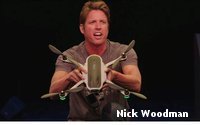 GoPro appears to be expanding its action cameras lineup to a broader connected ecosystem with new products and services introduced yesterday.
GoPro appears to be expanding its action cameras lineup to a broader connected ecosystem with new products and services introduced yesterday.
The world leader in action cameras announced the
Hero5 line of cameras, an aerial and handheld stabilization system and a cloud-based platform for content captured on the devices.
GoPro is stepping into the aerial market with its Karma
quadcopter system. Karma appears to operate similarly to other quadcopters and ‘drones,’ but the stabilizing gimbal and camera mount are on the front, rather than hanging below.
Also similar to other offerings currently on the market, the stabilizing gimbal can be removed and operated as a standalone device. The suggestion is that the stabilized camera system can merge the
two areas of capturing content on the ground and in the air into a singular, consumer-friendly system, according to GoPro.
advertisement
advertisement
While flying, consumers can operate Karma independently or as a team
with one person acting as pilot and the other as camera operator.
Through the use of the GoPro Passenger smartphone app, additional consumers with an Android or iOS smartphone can tap into the
camera on-board Karma to both view content and control the camera. This is functionally similar to the dynamic in professional aerial cinematography, but brings this connectivity and multi-user aspect
to the consumer market.
While most similar offerings available rely on a smartphone connected to the controller, the Karma controller integrates a touchscreen display and user interface
similar to GoPro’s other products and apps directly into the controller unit. A smartphone only comes into play when another user is controlling the camera through the passenger app or to
otherwise access the content on the camera after shooting.
On the camera side, the Hero5 Black gains native waterproofing without the need for a housing, an integrated LCD screen on the back
and digital image stabilization. The cameras also move to the new USB-C standard.
The cameras also gain voice control, with support for seven different languages at launch, as well as an
optional ‘REMO’ voice control remote for extended range. While operating the cameras, consumers can say ‘GoPro, take a picture’ or ‘GoPro, take a burst of photos’
all while the camera is shooting in other modes, according to GoPro.
Additionally, the LCD screen and overall user interface is simplified and appears to mirror the functionality and layouts
of GoPro’s current smartphone app. Users can adjust select parameters, such as modes, resolutions and framerates, without leaving the live preview and all changes are reflected in the image
immediately.
Hero5 cameras also connect to the cloud, in the form of a future subscription service called GoPro Plus. The cloud service aims to enable consumers to upload their content
directly from their cameras, to be accessed and edited with a smartphone or computer.
Another software component of the newly expanding ecosystem is GoPro Quik, which automates the editing
process for videos.
Through the smartphone or desktop application, consumers select which content they want compiled, in roughly which order and how long they want the video to be (the
smartphone app also includes presets for different social media platforms) and Quik takes care of the rest.
This is similar to other smartphone apps that can automate editing, but seems to be
designed specifically with the GoPro ecosystem in mind. From the app, consumers can share their videos and photos directly to various channels.
Overall, GoPro appears to be increasing the
overall capabilities of each product and its ecosystem as a whole, while minimizing the effort needed on the consumer side. Throughout the launch event, GoPro CEO Nick Woodman referenced the effort to
streamline and simplify the process for consumers to capture professional-level content on different devices, edit that content and share it across platforms.
This might be a trend within the
Internet of Things with another player in the connected farm market also minimizing
its focus on connected technology as a selling point and focusing on the significance of those capabilities on user behaviors.